|
Sennaya Ploschad
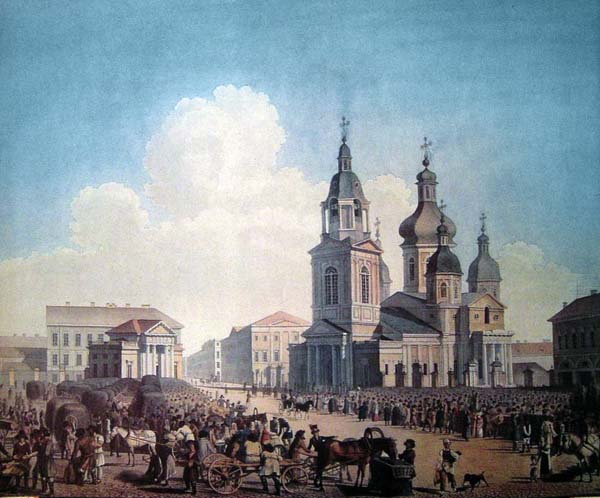
-- Alexander Brulloff, Sennaya Square in St. Petersburg. 1822-1826. Lithograph. |
In 1737 a market was established in St. Petersburg where hay, firewood, oats and
cattle were sold. It was located at the edge of the young city founded in 1703 and was probably named after the Hay Market in London, in Russian called the Sennaya Ploschad, "Hay Square."
As the city grew Sennaya Ploschad was incorporated into the city limits.
Here farmers, peasants and merchants all traded and it was called the "belly" of Saint Petersburg. As the area continued to grow the market became a part of the center of the city but still was occupied mostly by the lower classes.
The area near the hay market between Gribeodova Canal and the Moika Canal was known as a dubious area and has been integral to many works of literature, including Dostoevsky's "Crime and Punishment" in 1866.
The area was also well-known in the mid-19th century as a place of dubious activities. A book published in 1860, "The Slums of St. Petersburg" by Vsevolod Vladimirovich Krestovsky tells of difficult conditions, much centering on Sennaya Ploschad. Unfortunately, the book is not available in English for expanded readership.
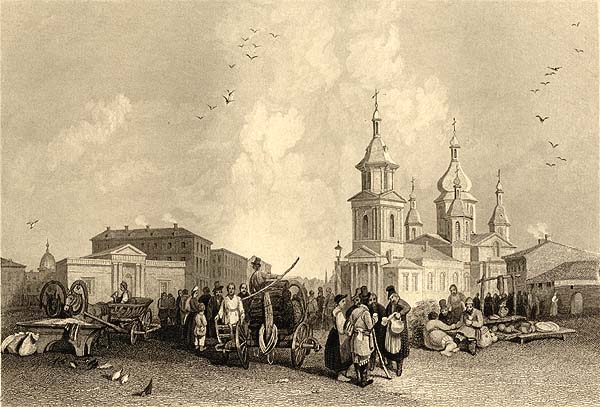
-- The Haymarket of St. Petersburg, drawn by A.G. Vickers, steel engraving, 1835.
Sennaya Square had become the cheapest and liveliest market in the capital of St Petersburg.
The place was known as the
very heart of the common folk's life, and that is why in Dostoevsky's "Crime and Punishment" the character
Raskolnikov, before he went to the police to plead guilty of the
murder he had committed, knelt and ecstatically kissed the
ground of the Sennaya Square in a frenzy to repent.
In the drawing a small building can be seen opposite the church of the
Assumption of the Mother of God (1753-1765). It is the Guardhouse
(1818-1820, the archiect V.I.Beretti). Here Dostoevsky was kept
under arrest on March 21-22, 1874, as the editor of the journal
Grazhdanin (Citizen) he was fined and sentenced to two days in
prison for violating the censorship rules.
A history book published in 1885 says this about Sennaya Ploschad:
The Sennaya Ploschad, or Hay Market, is the principal provision market, in which foreigners are amused with frozen animals and birds offered for sale.
This marketplace was the scene of a striking occurance in 1831, when the cholera was raging in St. Petersburg and 1,500 deaths were occuring daily. The people got the idea that the foreign doctors, who were numerous in the city, were poisoning them by wholesale. They assembled in crowds on the Sennaya marketplace, which is surrounded by low cabarets, in which the wildest rumours had been credited by half-drunken moujiks.
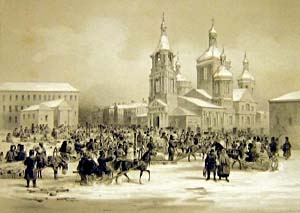
-- Winter in 1840 at Sennaya Ploschad and commerce is busy. |
Terrible shouts arose and the crowds were brandishing their axes, and the respectable class were fearful that a massacre was about to take place, when the Emperor Nicholas heard what was passing. He did not hesitate a moment, but jumped into a carriage and drove at once into the thick of the angry crowd. He descended in the midst of the rioters, walked intrepidly along their ranks, scanning them as he passed, then mounting the steps of a church, made but one sign to the people, and in a moment the 14,000 mutineers just now so eager to desolate the city with fire and sword sank on their knees as one man.
In the midst of profound silence that ensued the Czar's sonorous voice was heard form one end of the marketplace to the other. "Wherefore," he cried, "are you revolting against Heaven? Are you not the children of Holy Russia? and do you pretend to imitate revolutionists of other nations? Brothers, be yourselves once more! It is God who afflicts us. Instead of murmuring against the chastisement, let us acknowledge the power of Him who inflicts it, and supplicate Him to arrest the scourge that is ravaging our country."
Then the emperor knelt down, bowed his forehead to the granite steps, and the repentent crowd, after unitingn in his prayers, silently and respectfully withdrew.
|
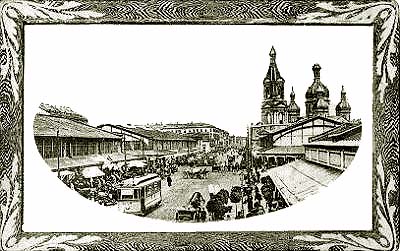
In 1765, the Church of the Assumption of the Virgin Mary, later immortalized in Fyodor Dostoevsky's "Crime and Punishment," was built on the Sennaya Ploshchad.
Sennaya Ploschad was a bustling, chaotic haymarket.
I gathered information about the social history of the Square from oral intereviews. I would appreciate more information and comments to expand this knowledge.
— David Owens
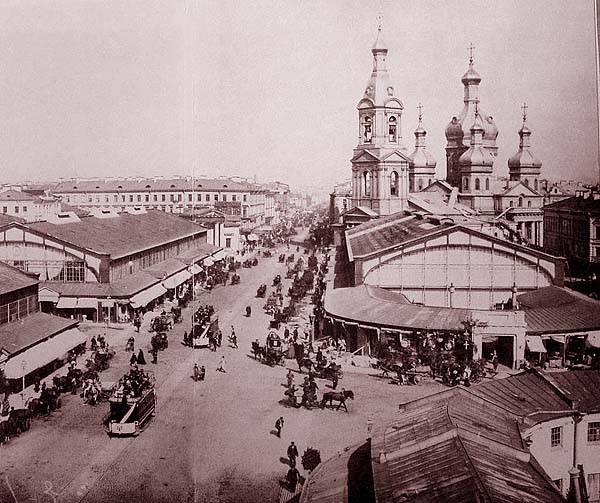
-- The Hay Market around 1900 showing large market buildings on the square. Again, looking up Sadovaya Street towards Nevsky Prospect.
The Church of the Assumption was a large and strong looking Church. It became the center for conservative orthodox thinking and symbol of old Russia that would persevere and rise again. A bastian against foreign influence and a magnet for conservative thought.
This was not always good. This is where the Czar would many persons with anti-foreign sentiment and it was here an angry mob could be assembled to purge whole area of town of "undesireable" residents. The mob would trash and burn anything and anyone in its path.
|
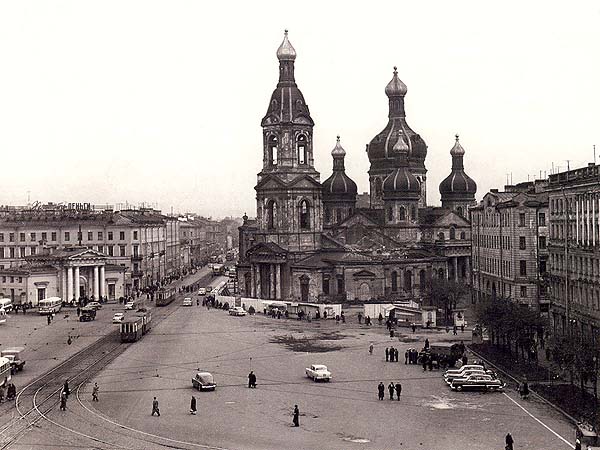
The Hay Market around 1960 just before the demolition of the Church of the Assumption. Double-decker trolley buses run up and down Sadovaya Street.
During the Soviet era the old market buildings were removed. Once again the Church of Assumption made a dominant presence on the square. It became a symbol for the strength of old Russia and the focal point for those who dared to think Russia could return to the old ways -- the foreigners would leave and Orthodoxy could replace the Soviet atheism and any encroaching foreign religions.
It was also the locale for the first real anti-soviet demonstrations in Saint Petersburg. And it was mostly government workers themselves who were protesting the plan to demolish the church to make way for a Metro station. Officials from the architectural commission and other agencies tried to stop it. They formed a wall around the church. But to no avail; they were all arrested and lost their jobs. And the battle to save the church was lost. The church had once again become controversial and a threat to stability.
In 1961 the church was demolished by order of local government to make way for a new metro station.
The church was one of the last Russian Orthodox churches in Leningrad (now Saint Petersburg) to fall victim to Soviet era city planning.
|
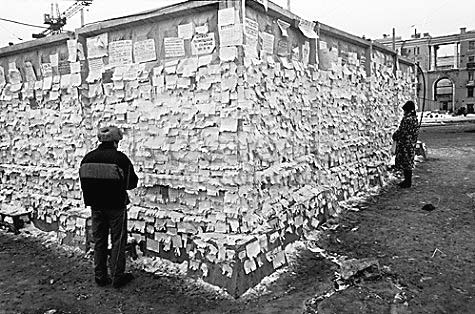
Sennaya Ploschad in February 1985 showing a construction barrier fence covered with announcements. Photo taken by Igor Stomahin.
|
The church was replaced by the Sennaya Ploshchad metro station.
In 2003 the city completed renovation of the Sennaya Square for the 300th birthday celebration of Saint Petersburg. The center of the square has modern steel and glass Metro stations and many new business structures. An area once inhabited by the most marginal characters of the city has become an upscale and trendy area.
The upscale Sennaya Ploschad in 2003 with new steel and glass Metro stations and shops and landscaping. 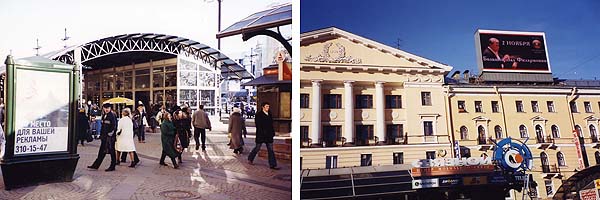
One Entrance to the Sadovaya/Sennaya Ploschad Metro Stations. A large video board was installed in 2003 in several prominent locations including Sennaya Ploshcad. photos David Owens |
Sennaya Ploschad Today |
Sennaya Home
Sennaya Ploschad Map

|
|


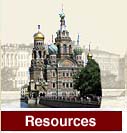
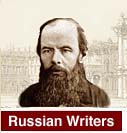








 Sennaya Ploschad — Hay Square
Sennaya Ploschad — Hay Square